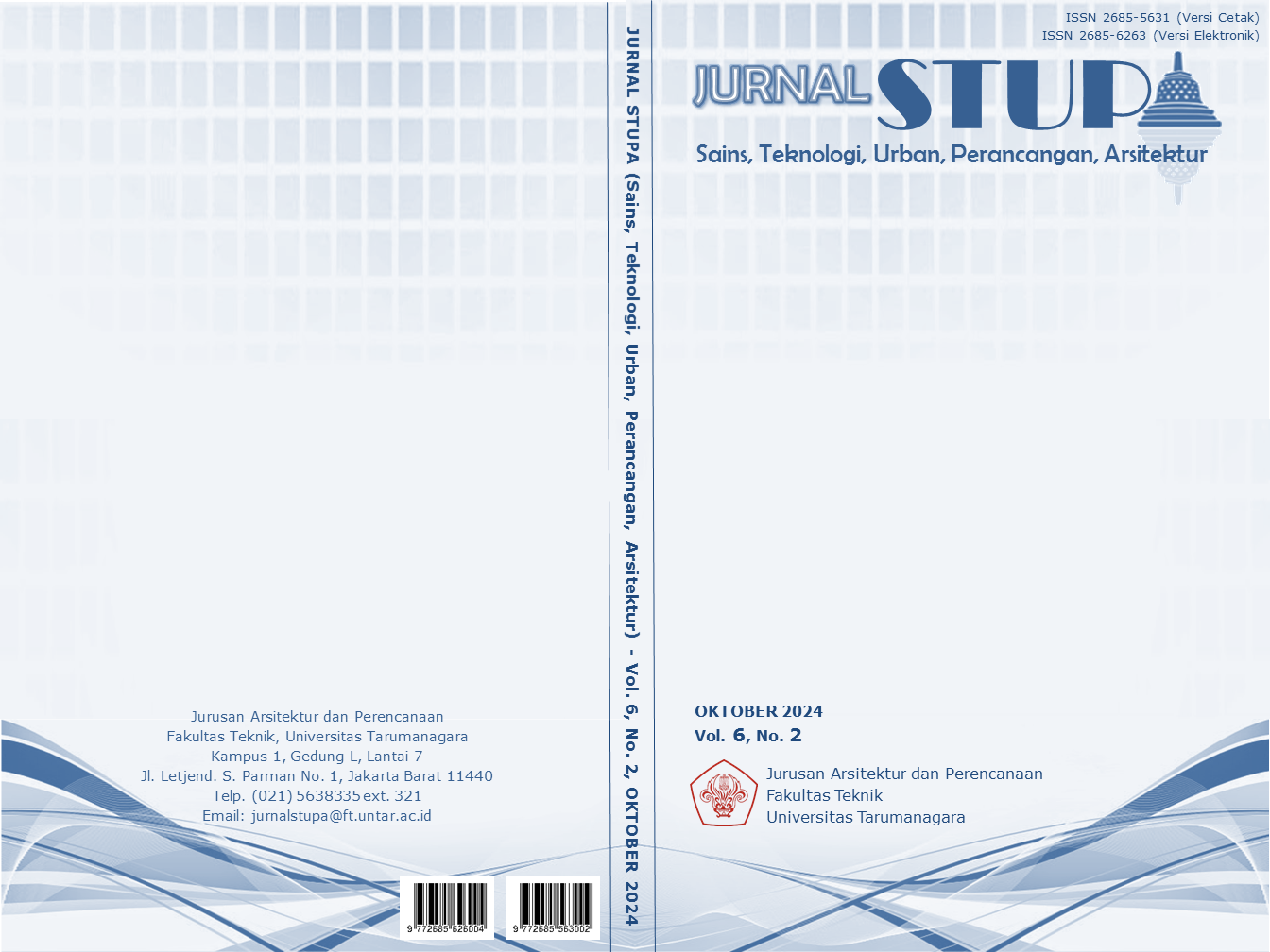PENERAPAN ARSITEKTUR NARATIF DI KAWASAN LOKASARI UNTUK MENGHIDUPKAN MEMORI KOLEKTIF PRINSEN PARK
Main Article Content
Abstract
Prinsen Park is the pioneer of the film industry in Indonesia which has given birth to many famous artists and actor and was given a nicknamed as tangkiwood. The glory of Prinsen Park began to fade due to a decline in interest in watching films and the development of analog television in the 1970s. Prinsen Park or what is now called Lokasari began to lose its original identity since the rejuvenation program which was implemented in 1985 and popping up of nightclubs in the area at the 90s. This project aims to restore the image of Prinsen Park and make the Lokasari area the center of community activities in Taman Sari. The cross section method was used to collect data through the process of observing existing areas accompanied by comparisons with historical evidence written in journals and books. The credibility of the data collected was strengthened through interviews with people regarding their impressions of the former location until now. The results of the analysis are a collection of collective community memories which were used in the design process to create the atmosphere of Prinsen Park in Lokasari. The atmosphere of Prinsen Park is presented again through the architectural narrative method. Narrative architecture plays a role in forming a collective memory which is useful in building an image of an area and building sense of place and sense of belonging among users to maintain the history of Prinsen Park and become a new chapter for the Lokasari.
Keywords: Lokasari; memory; narrative; park; Prinsen
Abstrak
Prinsen Park merupakan cikal bakal dari industri perfilm-an di Indonesia yang telah melahirkan banyak seniman dan aktor serta diberi julukan tangkiwood. Kejayaan dari Prinsen Park mulai pudar disebabkan penurunan minat menonton film dan berkembangnya televisi analog pada tahun 1970-an. Prinsen Park atau yang sekarang bernama Lokasari mulai kehilangan identitas aslinya sejak dilaksanakan program peremajaan pada tahun 1985 disertai dengan mulai menjamurnya klub malam di kawasan tersebut pada tahun 90-an. Proyek ini bertujuan untuk mengembalikan citra Prinsen Park dan menjadikan kawasan Lokasari sebagai pusat kegiatan masyarakat di Taman Sari. Metode cross section digunakan dalam pengumpulan data melalui proses observasi kawasan eksisting disertai perbandingan terhadap bukti sejarah yang tertulis pada jurnal dan buku, data yang dikumpulkan diperkuat kredibilitasnya melalui wawancara pada masyarakat mengenai impresi terhadap kawasan lokasari terdahulu hingga sekarang. Hasil analisis berupa kumpulan memori kolektif masyarakat yang digunakan dalam proses desain untuk menghadirkan suasana Prinsen Park di Lokasari. Suasana dari Prinsen Park kembali dihadirkan melalui metode naratif arsitektur. Arsitektur naratif berperan dalam membentuk memori kolektif yang berguna dalam membangun citra dari sebuah kawasan dan membangun sense of place serta sense of belonging pada pengguna untuk menjaga sejarah dari Prinsen Park dan menjadi lembaran baru bagi kawasan Lokasari.
Article Details

This work is licensed under a Creative Commons Attribution-NonCommercial-ShareAlike 4.0 International License.
This work is licensed under a Jurnal Sains, Teknologi, Urban, Perancangan, Arsitektur/ STUPA Creative Commons Attribution-NonCommercial-ShareAlike 4.0 International LicenseReferences
Saputra, G. (2016, Agustus 3). Hollywoodnya Jakarta! Senarai Kisah Masa Lalu Lokasari. Diperoleh 18 September, 2023, dari Jpnn.com: https://www.jpnn.com/news/hollywoodnya-jakarta-senarai-kisah-masa-lalu-lokasari
Sutanto, A. (2020). Peta Metode Desain. Jakarta: Universitas Tarumanagara, 227.
Miller, S. M. (2017). Aldo Rossi: The City as the Locus of Collective Memory and the Making of the Public City in Cold War Italy (Master's thesis, San José State University).
Nasyidah, L. (2013, April 12). Prinsen Park, Kenangan akan Taman Budaya. Diperoleh 18 September, 2023, dari Kompas.Com: https://regional.kompas.com/read/2013/04/12/04044738/prinsen.park.kenangan.akan.taman.budaya?page=all
Omhovère, C., & Tollance, P. 42.2| 2020 Place and Placelessness in Postcolonial Short Fiction.Jo, S. (2013, May). Aldo Rossi: Architecture and Memory. Journal of Asian Architecture and Building Engineering, II(26), 231-237. doi:10.1026/156
Relph, E. (1976). Place and placelessness. Pion Limited.
Wachoński, D. (2020, August 8). Collective memory in architecture. Method in Architecture, I(9), 98-109. doi:10.4050/ces.1296
Zerubavel, E. (2003). Time maps: Collective memory and the social shape of the past. University of Chicago Press.



